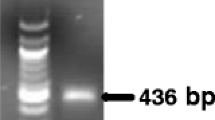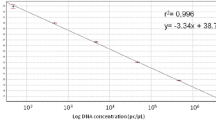Abstract
Phytophthora kernoviae is a recently described pathogen causing leaf blight, aerial dieback and bleeding cankers on trees and shrubs in parts of Great Britain and Ireland and recently reported in New Zealand. This paper describes the development of a TaqMan real-time PCR assay based on internal transcribed spacer (ITS) sequence to aid diagnosis of this pathogen in culture and in plant material. The assay showed no cross reaction with 29 other Phytophthora species, including the closely related species P. boehmeriae, and detected at least 1.2 pg of P. kernoviae DNA per reaction. A rapid and simple method can be used to extract DNA prior to testing by real-time PCR, and a plant internal control assay can be used to aid interpretation of negative results. A comparison of real-time PCR and plating for 526 plant samples collected in the UK indicated that this assay is suitable for use in routine screening for P. kernoviae.


Similar content being viewed by others
References
Anonymous (2004). Statutory instrument No. 3367. The Plant Health (Phytophthora kernovii Management Zone) (England) order 2004. HMSO. ISBN 0110513878
Anonymous. (2006). EPPO diagnostic protocol for regulated pests: Phytophthora ramorum. EPPO Bulletin, 36, 145–155.
Beales, P. A., Lane, C. R., Barton, V. C., & Giltrap, P. M. (2006). Phytophthora kernoviae on ornamentals in the UK. EPPO Bulletin, 36, 377–379.
Beales, P. A., Giltrap, P. M., Payne, A., & Ingram, N. (2009). A new threat to UK heathland from Phytophthora kernoviae on Vaccinium myrtillus in the wild. Plant Pathology, 58, 393.
Bilodeau, G. J., Lévesque, C. A., de Cock, A. W. A. M., Duchaine, C., Brière, S., Uribe, P., et al. (2007). Molecular detection of Phytophthora ramorum by real-time polymerase chain reaction using TaqMan, SYBR Green and molecular beacons. Phytopathology, 97, 632–642.
Blair, J. E., Coffey, M. D., Park, S. Y., Geiser, D. M., & Kang, S. (2008). A multi-locus phylogeny for Phytophthora utilizing markers derived from complete genome sequences. Fungal Genetics and Biology, 45, 266–277.
Brasier, C. M., Beales, P. A., Kirk, S. A., Denman, S. & Rose, J. (2005). Phytophthora kernoviae sp. Nov., an invasive pathogen causing bleeding stem lesions on forest trees and foliar necrosis of ornamentals in the UK. Mycological Research, 109, 853–859
Erwin, D. C., & Ribeiro, O. K. (1996). Phytophthora diseases worldwide. St. Paul, MN, USA: American Phytopathological Society.
Hayden, K. J., Rizzo, D., Tse, J., & Garbelotto, M. (2004). Detection and quantification of Phytophthora ramorum from Californian forests using a real-time polymerase chain reaction assay. Phytopathology, 94, 1075–1083.
Hayden, K., Ivors, K., Wilkinson, C., & Garbelotto, M. (2006). TaqMan chemistry for Phytophthora ramorum detection and quantification, with a comparison of diagnostic methods. Phytopathology, 96, 846–854.
Hughes, K. J. D., Fulton, C. E., McReynolds, D., & Lane, C. R. (2000). Development of new PCR primers for identification of Monilinia species. EPPO Bulletin, 30, 507–511.
Hughes, K. J. D., Giltrap, P. M., Barton, V. C., Hobden, E., Tomlinson, J. A., & Barber, P. (2006). On-site real time PCR detection of Phytophthora ramorum causing dieback of Parrotia persica in the UK. Plant Pathology, 55, 813.
Hughes, K. J. D., Tomlinson, J. A., Griffin, R. L., Boonham, N., Inman, A. J., & Lane, C. R. (2006). Development of a One-Step Real-Time PCR Assay for Diagnosis of Phytophthora ramorum. Phytopathology, 96, 975–981.
Jeffers, S. N., & Martin, S. B. (1986). Comparison of two media selective for Phytophthora and Pythium species. Plant Disease, 70, 1038–1043.
Kroon, L. P. N. M., Bakker, F. T., van den Bosch, G. B. M., Bonants, P. J. M., & Flier, W. G. (2004). Phylogenetic analysis of Phytophthora species based on mitochondrial and nuclear DNA sequences. Fungal Genetics and Biology, 41, 766–782.
Lane, C. R., Hobden, E., Walker, L., Barton, V. C., Inman, A. J., Hughes, K. J. D., Swan, H., Colyer, A. & Barker, I. (2007). Evaluation of a rapid diagnostic field test kit for identification of Phytophthora species, including P. ramorum and P. kernoviae at the point of inspection. Plant Pathology, 56, 828–835
Martin, F. N., Tooley, P. W., & Blomquist, C. (2004). Molecular detection of Phytophthora ramorum, the causal agent of sudden oak death in California, and two additional species commonly recovered from diseased plant material. Phytopathology, 94, 621–631.
Mumford, R., Boonham, N., Tomlinson, J., & Barker, I. (2006). Advances in molecular phytodiagnostics - new solutions for old problems. European Journal of Plant Pathology, 116, 1–19.
Ramsfield, T. D., Dick, M. A., Beever, R. E. & Horner, I. J. (2007). Phytophthora kernoviae – of Southern Hemisphere origin? Abstracts of the Fourth IUFRO working party meeting 7.02.09. Phytophthoras in Forests and Natural Ecosystems, Monterey, CA, USA August 26–31 2007.
Schena, L., Hughes, K. J. D. & Cooke, D. E. L. (2006). Detection and quantification of Phytophthora ramorum, P. kernoviae, P. citricola, and P. quercina in symptomatic leaves by multiplex PCR. Molecular Plant Pathology, 7, 365–379
Tomlinson, J. A., Barker, I., & Boonham, N. (2007). Faster, simpler, more-specific methods for improved detection of Phytophthora ramorum in the field. Applied and Environmental Microbiology, 73, 4040–4047.
Tomlinson, J. A., Boonham, N., Hughes, K. J. D., Griffin, R. L., & Barker, I. (2005). On-site DNA extraction and real-time PCR for detection of Phytophthora ramorum in the field. Applied and Environmental Microbiology, 71, 6702–6710.
Tomlinson, J. A., Dickinson, M., Hobden, E., Robinson, S., Giltrap, P. M. & Boonham, N. (2010). A five-minute DNA extraction method for expedited detection of Phytophthora ramorum following prescreening using Phytophthora spp. lateral flow devices. Journal of Microbiological Methods, 81, 116–120
Vettraino, A. M., Sukno, S., Vannini, A., & Garbelotto, M. (2010). Diagnostic sensitivity and specificity of different methods used by two laboratories for the detection of Phytophthora ramorum on multiple natural hosts. Plant Pathology, 59, 289–300.
Widmer, T. L. (2010). Phytophthora kernoviae oospore maturity, germination, and infection. Fungal Biology, 114, 661–668.
Acknowledgements
Funding for this work was provided by Plant Health Division of Defra and work was performed under license number PHL 251A/4736 (03/20004). The authors would like to thank Dr Paul Beales and Dr Rebecca Weekes for their invaluable support and guidance.
Author information
Authors and Affiliations
Corresponding author
Rights and permissions
About this article
Cite this article
Hughes, K.J.D., Tomlinson, J.A., Giltrap, P.M. et al. Development of a real-time PCR assay for detection of Phytophthora kernoviae and comparison of this method with a conventional culturing technique. Eur J Plant Pathol 131, 695–703 (2011). https://doi.org/10.1007/s10658-011-9843-x
Accepted:
Published:
Issue Date:
DOI: https://doi.org/10.1007/s10658-011-9843-x




